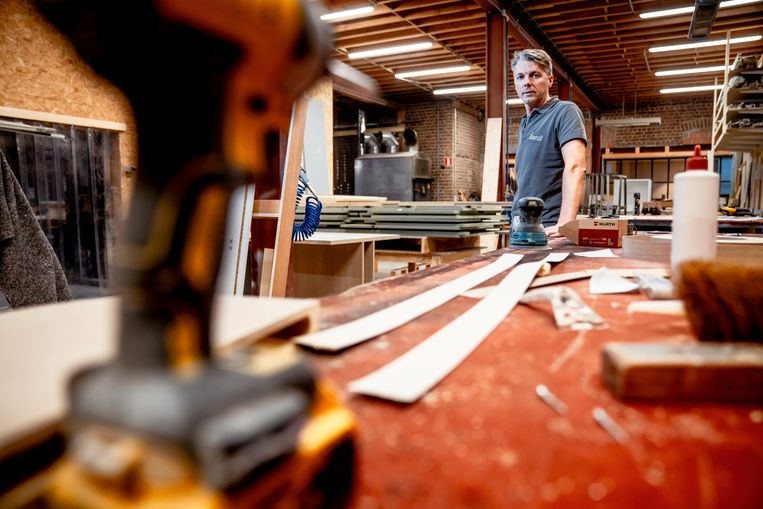When schools introduce a new direction, they prefer to choose sports rather than construction. However, the labor market mainly requires the latter. Why don't we get schools, youth and families interested in technical and vocational training?
It's still there, the coffee table that Cornel Benoit, 41, made in class his third year and was allowed to take home. To this day he still feels happy when he sees the table, just as he was happy when he came home with something he made himself. He says: “My brothers who studied Modern were unable to do that.”
Today, Benoit runs his own company, specializing in custom furniture. What started as a one-man company thirteen years ago is now a company with ten employees. “About every two years, I have to hire someone new,” he says. He finds faculty through dual learning, a form of education in which students learn in the company three days a week. “So I can't complain, because in general it's hard to find people,” says Benoit.
This is also what concerns the Social and Economic Council of Flanders (SERV). He warns – and not for the first time – that the new trends that schools want to initiate do not provide a sufficient solution to the shortage in the labor market. Schools prefer to start with a sports, office or arts and creativity course. The large number of applications for sports training is particularly striking: previously it was one in twenty, now one in five.
Sexier
Young people simply love sports. It looks more attractive than wooden techniques, for example. Therefore, schools that are supported on the basis of student numbers are more likely to organize popular courses. Courses such as construction, electrical or carpentry will then be left out in the cold.
“We cannot complain about general training in woodworking. There are more than a hundred schools in Flanders that offer this,” says Bart de Waele of the Woodwize sectoral knowledge and training centre. But he is concerned about the specializations that are offered, for example, through learning Double or Year 7. “Schools easily choose to specialize in interior construction, while we need specialized courses such as staircase maker, furniture maker, or interior and parking designer.”
SERV calls for the supply of schools to be more closely aligned with labor market needs. But convincing schools of this is not easy – and organizing technical courses is not always easy. The shortage of teachers is clearly felt by practical wood and electrical teachers. “Plus, they are often expensive: you need big studios, a lot of machines, and you have to keep up with digital transformation,” says Miki Valcke, education expert at SERV. In order to be able to share these costs and employees specifically, SERV calls for greater cooperation with companies.
By the way, it's one thing to convince schools of technology options, you also have to get parents and students interested. “I have been working in an art school for 35 years, and I have been trying to improve this image for 35 years,” says Benny Vandevoorde, director of the Tectura School in Ghent. He divides the directions he provides into “soft” technical directions such as office and “hard” technical directions such as construction, woodworking or auto mechanics. The latter is less popular in his school. “In the perception of parents, the latter are ‘dirty’ trends, as their children will receive less wages.”
Benoit also notes this perception problem sometimes. “People don't mean it in a bad way, but sometimes they tell me I've reached that goal too,” he says. The basic idea – that a person who has learned a trade will only be able to achieve it if he can develop his own business – bothers him. He says, “What's wrong with a good worker who works for his boss?”

To discover
Nothing is the answer, according to Martin Valcke, Emeritus Professor of Educational Sciences (UGent). “Moreover, for many young people who discover a direction in which they can work on a concrete solution, everyday problems represent a real relief. Many of them feel better about themselves afterwards than if they had stayed in the mainstream.”
The professor believes that the government also suffers from this image problem. “The aim of modernizing secondary education was to remove the divisions between ASO, TSO and BSO. This has been obstructed, so we are now left with a failure to modernize.
However, Flemish Education Minister Ben Wiets (N-VA) and his colleague from Werk Jo Brouns (CD&V) are working on a “plan to strengthen TSO and BSO”. But it is significant that after introducing his rule that new courses must have at least five students, Wits quickly made a possible exception for Latin. While de Waile and his colleagues have been calling for more flexibility in the provision of specialty years for years, such a rule makes it “almost impossible” to organize the necessary specialty wood directives.
The question remains what can be done. The solution proposed by many experts is simple: ensure that everyone in education, from elementary teachers to CLB staff, knows technical and professional fields better.
“A sixth-grader recently visited here to inspire them in choosing a school,” Vandeford says. “Their teacher was shocked when she entered our studios: ‘I didn’t know you worked with so many computers!’ The fact that the teacher would say something like that helps explain the incorrect image that sometimes exists about us.

“Total coffee specialist. Hardcore reader. Incurable music scholar. Web guru. Freelance troublemaker. Problem solver. Travel trailblazer.”







More Stories
Bitcoin price rises after new jobs data from US
European stock markets open higher | beursduivel.be
Russia’s oil imports to China decline